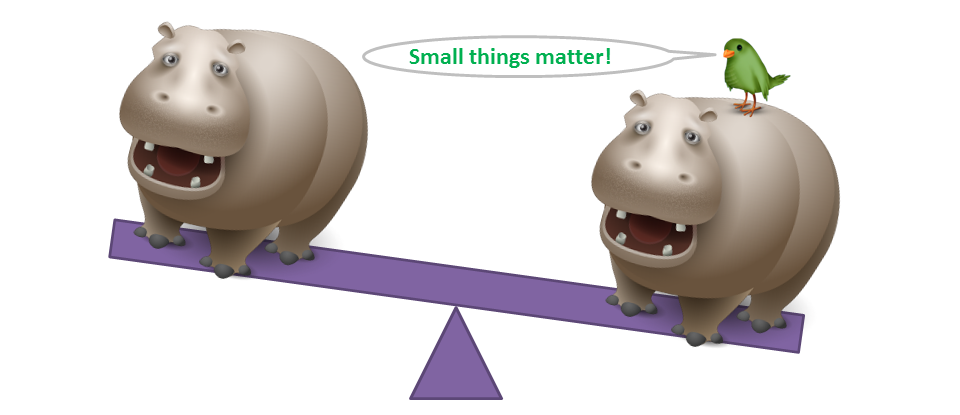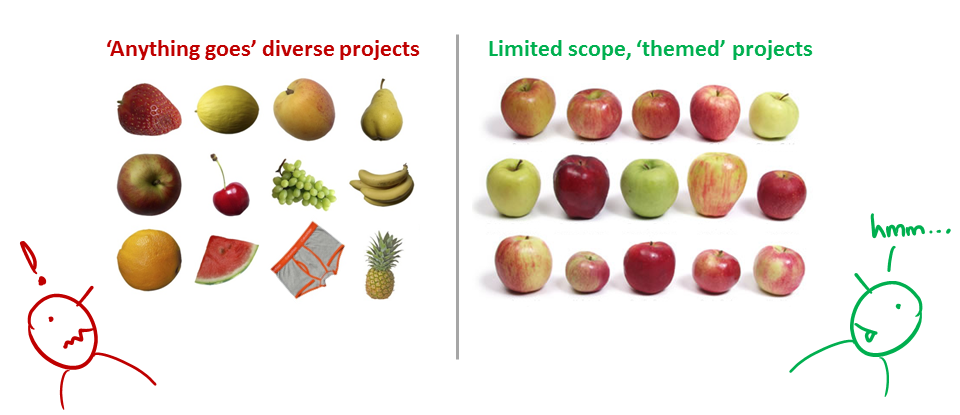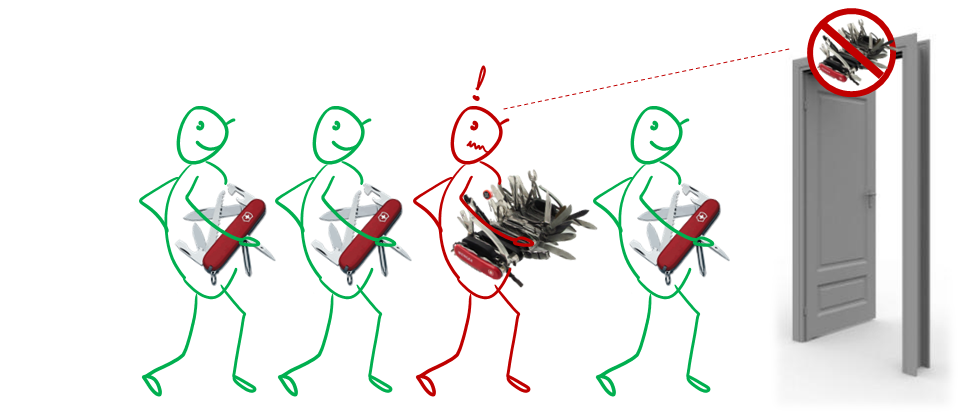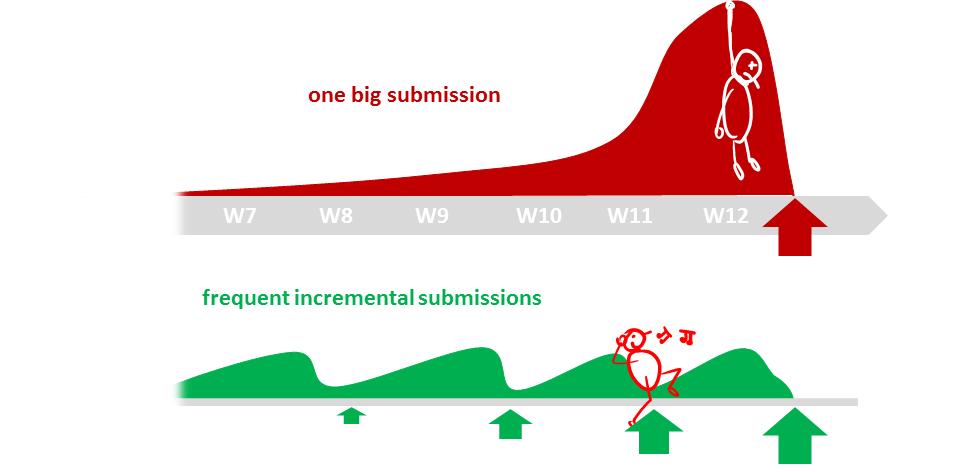FAQs on: General
The Schedule page presents all you need to know in chronological order while the other pages have some of the same content organized by topic.
The Schedule page is the one page you need to refer weekly. Although there is a lot of content in the Admin Info page and the Textbook page -- which you are welcome to read in those respective pages -- the same content is also embedded in the relevant weeks of the Schedule page. Embedded extracts usually appear in expandable panels and can be identified by the symbol in the panel title.
In CS2113, A+ is not given simply based on the final score. To get an A+ you should,
- score enough to be close to the higher end of the
Agrade band. - be considered technically competent by peers and tutor (based on peer evaluations and tutor observations).
- be considered helpful by peers (based on peer evaluations and tutor observations).
- In particular, you are encouraged to be active on the forum and give your inputs to ongoing discussions so that other students can benefit from your relatively higher expertise that makes you deserve an A+.
- Whenever you can, go out of your way to review pull requests created by other team members.

Sometimes, small things matter in big ways. e.g., all other things being equal, a job may be offered to the candidate who has the neater looking CV although both have the same qualifications. This may be unfair, but that's how the world works. Students forget this harsh reality when they are in the protected environment of the school and tend to get sloppy with their work habits. That is why we reward all positive behavior, even small ones (e.g., following precise submission instructions, arriving on time etc.).
But unlike the real world, we are forgiving. That is why you can still earn full marks for participation even if you miss a few things here and there.
Related article: This Is The Personality Trait That Most Often Predicts Success (this is why we reward things like punctuality).
Defining your own unique project is more fun.
But, wider scope → more diverse projects → harder for us to go deep into your project. The collective know-how we (i.e., students and the teaching team) have built up about SE issues related to the project become shallow and stretched too thinly. It also affects fairness of grading.

That is why a strictly-defined project is more suitable for a first course in SE that focuses on nuts-and-bolts of SE. After learning those fundamentals, in higher level project courses you can focus more on the creative side of software projects without being dragged down by nuts-and-bolts SE issues (because you already know how to deal with them). However, we would like to allow some room for creativity too. That is why we let you build products that are slight variations of a given theme.
Also note: The freedom to do 'anything' is not a necessary condition for creativity. Do not mistake being different for being creative. In fact, the more constrained you are, the more you need creativity to stand out.

We have chosen a basic set of tools after considering ease of learning, availability, typical-ness, popularity, migration path to other tools, etc. There are many reasons for limiting your choices:
Pedagogical reasons:
- Sometimes 'good enough', not necessarily the best, tools are a better fit for beginners: Most bleeding edge, most specialized, or most sophisticated tools are not suitable for a beginner course. After mastering our toolset, you will find it easy to upgrade to such high-end tools by yourself. We do expect you to eventually (after this course) migrate to better tools and, having learned more than one tool, to attain a more general understanding about a family of tools.
- We want you to learn to thrive under given conditions: As a professional Software Engineer, you must learn to be productive in any given tool environment, rather than insist on using your preferred tools. It is usually in small companies doing less important work that you get to chose your own toolset. Bigger companies working on mature products often impose some choices on developers, such as the project management tool, code repository, IDE, language etc. For example, Google used SVN as their revision control software until very recently, long after SVN fell out of popularity among developers. Sometimes this is due to cost reasons (tool licensing cost), and sometimes due to legacy reasons (because the tool is already entrenched in their codebase). While programming in school is often a solo sport, programming in the industry is a team sport. As we are training you to become professional software engineers, it is important to get over the psychological hurdle of needing to satisfy individual preferences and get used to making the best of a given environment.
Practical reasons:
- Some of the topics are tightly coupled to tools. Allowing more tools means tutors need to learn more tools, which increases their workload.
- We provide learning resources for tools. e.g. 'Git guides'. Allowing more tools means we need to produce more resources.
- When all students use the same tool, the collective expertise of the tool is more, increasing the opportunities for you to learn from each others.
Meanwhile, feel free to share with peers your experience of using other tools.

The high number of submissions is not meant to increase workload but to spread it across the semester. Learning theory and applying them should be done in parallel to maximize the learning effect. That can happen only if we spread theory and 'application of theory' (i.e., project work) evenly across the semester.
In addition, spreading the work across the semester aligns with the technique that we apply in this course to increase your retention of concepts learned.
In most quizzes, answers will be released within a day after the quiz deadline.
On a related note, if you are not confident about the answer you've selected for a question, you are welcome to discuss it in the forum, even if the submission deadline is not over yet (but one question per thread please).
FAQs on: tP
Yes (an example), although having too many non-coding tasks in the issue tracker can make it cluttered.
GitHub Issues does not have a direct way of doing this. However, you can use a task list in the issue description to indicate sub-tasks and corresponding issues/PRs -- (an example)
This is discouraged in the tP, as it makes task allocations (and accountability) harder to track.
Instead, shared tasks can be split into separate issues. For example, instead of creating an issue Update teams page with own info and assigning it to all team members (in which case, this issue can't be closed until all members do their part), you can create issues such as Update teams page with John's info that can be assigned to individual members.
A: In the tP (in which our grading scripts track issues assigned to each member), it is better to create separate issues so that each person's work can be tracked separately. For example, suppose everyone is expected to update the User Guide (UG). You can create separate issues based on which part of the UG will be updated by which person e.g., List-related UG updates (assigned to John), Delete-related UG updates (assigned to Alice), and so on.
This is encouraged, while not a strict rule. Creating an issue indicates 'a task to be done', while a PR is 'a task being done'. These are not the same, and there can be a significant time gap between the two.
Furthermore, posting an issue in advance allows the team to,
- anticipate a PR is coming
- discuss more about the task (in the issue thread) e.g., alternatives, priority
- indicate who will be doing the task (by adding an assignee), when it should be done (by adding it to a milestone)
Not surprisingly, a common question tutors receive is "can you look at our project and tell us if we have done enough to get full marks?". Here's the answer to that question:
The tP effort is graded primarily based on peer judgements (tutor judgements are used too). That means you will be judging the effort of another team later, which also means you should be able to make a similar judgement for your own project now. While we understand effort estimating is hard for software projects, it is an essential SE skill, and we must practice it when we can.
The expected minimum bar to get full marks for effort is given here.
If you surpass the above bars (in your own estimation), you should be in a good position to receive full marks for the effort. But keep in mind that there are many other components in the tP grading, not just the effort.
In that case, at a later stage, you can add more user stories until there is enough for a meaningful work distribution. But at this point focus on selecting the smallest sub-set of must_have user stories only.
Here are some reasons:
- We want you to take at least two passes at documenting the project so that you can learn how to evolve the documentation along with the code (which requires additional considerations, when compared to documenting the project only once).
- It is better to get used to the documentation tool chain early, to avoid unexpected problems near the final submission deadline.
- It allows receiving early self/peer/instructor feedback.
In terms of effort distribution, it's up to the team to tell us who did how much. Same goes for assigning bugs. So, it's fine for someone to take over a feature if the team is able to estimate the effort of each member, and they have a consensus on who will be responsible for bugs in that feature.
For code authorship, only one person can claim authorship of a line, and that person will be graded for the code quality of that line. By default, that will be the last person who edited it (as per Git data) but you can override that behavior using @@author tags.